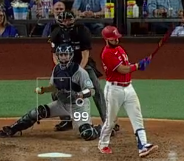Yadiel Hernandez, Sleeping Giant
Stop me if you’ve heard this one before. Why is it so easy to fill in the pool that the Washington Nationals own? That’s right — it has no depth. The Nats have relied on a stars-and-scrubs approach for years, hoping that their stellar headliners can offset some of the clunkers at the bottom of the roster. Sometimes it works and sometimes it doesn’t, but the central motivation behind their roster has been strikingly consistent in recent years.
In 2021, some of the stars aren’t shining as brightly as the team hoped. Juan Soto has missed three weeks with injury and is off to a slow, power-sapped start. Stephen Strasburg made only two starts before landing on the Injured List. Patrick Corbin has been disastrous. Offseason acquisitions Josh Bell and Kyle Schwarber, who were supposed to stabilize the lineup, are off to slow starts, Bell in particular. It’s not a great year for the boom/bust roster-building philosophy.
In a great stroke of irony, however, the Nats have found a solid bat that could lengthen their lineup and give Soto and Trea Turner some help. There are just two problems: they have nowhere to play him, and he still has some tinkering to do. Yadiel Hernandez looks like the kind of hitter that good teams need, an above-average bat summoned from the minors. Due to the team’s roster construction, he’s been banished to the bench. Should a spot open up, however, he might be the exact thing the team has been missing.
Read the rest of this entry »


